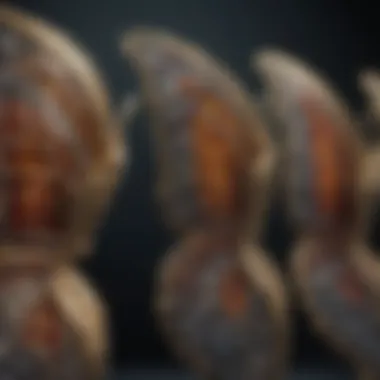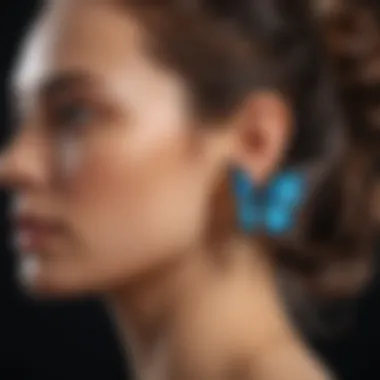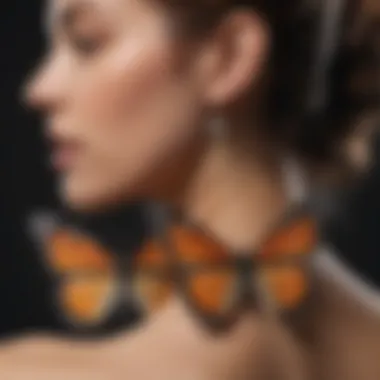Understanding Butterfly Backs for Earrings


Intro
When it comes to the fine art of accessorizing, the nuances of earring design truly make a statement. Among the various components that contribute to the overall charm of a pair of earrings, butterfly backs stand out as both functional and aesthetically pleasing. This section sets the stage for a deeper exploration into these crucial attachments that provide security and style to pierced earrings.
Butterfly backs, often called butterfly clasps, have been a go-to choice for many jewelry lovers. Their design allows for easy application and removal, providing practicality without sacrificing elegance. Throughout history, various earring backs have existed, but the butterfly style has maintained its popularity for good reason.
In the sections that follow, we shall journey through topics including the design elements that define butterfly backs, their historical significance, and how they stack up against alternative earring back designs. We’ll also touch on practical considerations that every wearer should contemplate, ensuring that the ultimate choice enhances both comfort and appeal. So fasten your seatbelts as we dive into the intricate world of butterfly backs and the critical role they play in the realm of jewelry.
Preface to Butterfly Backs
When one thinks of earrings, the spotlight often shines on their aesthetic beauty, shimmering gemstones, or intricate designs, yet the spotlight should also illuminate the unsung hero: the earring back. Among various types of earring backs, butterfly backs stand out for good reason. This section dives deep into why butterfly backs are not just an accessory but a crucial component in securing a piece of jewelry that can be both striking and sentimental.
Butterfly backs, also known as butterfly clasps or push backs, are renowned for their user-friendly design and reliable grip. Sporting a simple mechanism, they offer a perfect blend of sophistication and practicality, making them widely preferred among wearers. Whether it's a pair of diamond studs or a casual drop earring, these backs assure that the earring stays right where it should be—with the wearer, not lost on the floor.
Key Elements of Butterfly Backs
Design and Functionality
The charm of butterfly backs lies in their clever design. Consisting of a small, wing-like structure made of metal, they have a central tunnel through which the earring post slides. This clever design allows for quick application and removal. They squeeze lightly against the ear lobe, providing enough tension to keep the earring secure without causing discomfort.
Benefits and Considerations
Several benefits accompany the selection of butterfly backs:
- Ease of Use: These backs rank high on the accessibility scale, easily manipulated by even those with limited dexterity.
- Comfort: Unlike some other styles that can dig into the skin, butterfly backs hug the earlobe without irritation, making them an ideal choice for everyday wear.
- Versatility: They pair well with many earring types—from delicate studs to heavier pieces—thus enhancing their appeal across a range of jewelry.
Yet, it’s crucial to consider a few caveats. Some users find that butterfly backs can occasionally come loose if not secured properly, leading to potential loss of the earring. Despite this, their popularity persists, primarily due to their overall advantage in usability and comfort.
Epilogue
Historical Context of Earring Backs
Understanding the historical context of earring backs sheds light on both the evolution of personal adornment and the intricate relationship between culture and ornamentation. Earring backs are not merely utilitarian components; they serve as a bridge connecting modern fashion to practices that can be traced back thousands of years. This segment will explore how these accessory elements have changed over time, answering questions about their initial functions, styles, and cultural significance.
The Evolution of Earring Designs
Earrings, like many forms of jewelry, have morphed through different centuries and cultures. Initially, earrings were revisited in ancient civilizations, where they were painstakingly crafted using materials like gold, silver, and even gemstones. These early designs often reflected the status and wealth of the wearer, thereby giving ear adornments a distinct social weight.
As time marched on, the design of earrings began to reflect shifts in societal norms and technological advancements. In the Middle Ages, for instance, earrings often fell out of favor among European nobility, only to be revived during the Renaissance when they became a symbol of artistry and elegance.
With each passing era, the mechanisms of holding these beauts in place also evolved. The advent of the butterfly back design in the 20th century marked a turning point. This simple but cleverly designed backing offered both comfort and security, captivating wearers who appreciated innovation but also cherished a nod to historical aesthetics.
"Jewelry tells a story, and earring backs are the unsung heroes of that narrative, holding precious memories and treasured designs together."
Types of Earring Backs Through the Ages
The types of earring backs have demonstrated how practicalities often influence aesthetics. What began with simple wire loops transitioned into more specialized designs. Here’s a brief overview of how designs have morphed:
- Wire Backs: Common in antiquity, these are perhaps the simplest form, allowing for ease of wear but lacking security.
- Screw Backs: Developed in the early 20th century, these featured a threaded post that provides a secure hold, ideal for precious stones.
- Latch Backs: Often used in hoops, these allow for a seamless fit while enhancing comfort with their smooth mechanism.
- Butterfly Backs: Introduced later, butterfly backs are now a favorite choice for their combination of functionality and elegance. They offer an almost invisible profile, ensuring that the focus remains on the earring's design itself.
Earring backs are much more than mere connectors; they embody and represent cultural traditions and technological advancement. They are a testament to the evolution of craftsmanship in adornment, as each design iteration reflects both necessity and desire. Understanding their historical context enriches one's appreciation for this often-overlooked aspect of jewelry.
Understanding Butterfly Backs
In the realm of jewelry, particularly pierced earrings, butterfly backs play a crucial role that often goes unnoticed. Their design and functionality not only enhance the aesthetic appeal of earrings but also address practical concerns that wearers may have. By understanding the nuances of butterfly backs, enthusiasts and designers can make informed choices that elevate both style and comfort.
Design and Mechanism


The design of butterfly backs is quite minimalist, yet it serves a functional purpose. Typically made up of two wings that pivot open and close, they allow for a secure fit on the post of the earring. This pivoting mechanism is what enables the wearer to easily put the earrings on and take them off. Unlike some other backings that require additional strength to close, butterfly backs can be manipulated effortlessly, making them particularly appealing for everyday wear.
One interesting aspect is the way butterfly backs distribute pressure evenly across the earlobe. This can help to minimize discomfort, especially for those who wear heavier earrings. The flared design of the wings means that they hold the earring firmly in place without pinching too hard on the earlobe.
Materials Used
Materials really matter when it comes to the durability and comfort of butterfly backs. They are often made from various metals including sterling silver, gold, and stainless steel.
- Sterling Silver: A classic choice, known for its elegance. It's relatively soft and can be shaped easily into the desired design but may require regular polishing to maintain its luster.
- Gold: Frequently favored for its luxurious look and hypoallergenic properties. Gold butterfly backs provide an upscale aesthetic but can be heavier than other materials, which might not be suitable for those with sensitive ears.
- Stainless Steel: A more affordable option, known for its strength and resistance to tarnish. This makes it ideal for everyday wear, especially for people who are not very diligent about jewelry maintenance.
In recent years, there has been a shift towards using more sustainable materials in jewelry making, including bamboo and recycled metals. This is a testament to a growing consciousness regarding environmental impact among both consumers and designers. These developments indicate that the butterfly back might evolve alongside trends in sustainability while maintaining its essential structural role in earring design.
"The aesthetic appeal of butterfly backs is only matched by their practicality, providing both comfort and security. The materials chosen can enhance not just the look but also the overall experience of wearing earrings."
Understanding butterfly backs is about more than just functionality; it is about appreciating the blend of design, comfort, and ethical considerations. Each detail, from the mechanics to the materials, contributes to the earring's overall experience, making them significant components worthy of attention in the jewelry conversation.
Functionality of Butterfly Backs
Understanding the functionality of butterfly backs is crucial for anyone considering pierced earrings. This topic not only highlights the practical advantages of these earring backs but also reflects on their importance in enhancing the overall experience of wearing earrings.
Ease of Use
Butterfly backs are recognized for their simple yet effective design. Using them is as easy as pie, which appeals to many wearers, especially those who may be new to earrings. They consist of a flat disc attached to a post with a hinge mechanism that securely snaps into place behind the ear.
The user just needs to position the earring post through the earlobe, and then slide on the butterfly back. With a gentle pinch, the earring is securely held in place without much fuss. This ease of operation is beneficial for individuals who might have dexterity issues or those who are in a rush.
Additionally, butterfly backs are less likely to cause irritation due to their lightweight nature. They distribute pressure evenly, ensuring that the wearing experience is comfortable throughout the day. This is particularly significant for people who wear earrings regularly or for extended periods.
"Butterfly backs simplify the earring experience, making it accessible for every wearers."
Security Features
When it comes to security, butterfly backs deliver on multiple fronts. One of their standout features is how they grip the earring post. The upward and downward movement of the back provides a snug fit that helps prevent accidental slipping off. This security is particularly valuable in social environments where one might be more active, like dancing or participating in sports.
Moreover, they come in various sizes to cater to different types of earrings, ensuring that heavier pieces have the same reliable hold as lighter ones. Some butterfly backs even incorporate additional features like grooves or notches, further enhancing their grip.
In terms of risk management, it’s worth noting that these types of earring backs can be less prone to loss. Unlike screw-on backs, which require more effort to apply, butterfly backs allow for quick adjustments without the risk of detaching inadvertently. This means less worry about losing precious or sentimental earrings, which is a common concern among jewelry enthusiasts.
In summary, the combination of ease of use and robust security features makes butterfly backs a functional choice for both casual wearers and collectors alike. The practical aspects blend beautifully with the aesthetic, merging form with function in a way that elevates the earring experience.
Comparing Earring Back Types
When it comes to selecting your perfect pair of earrings, the choice of earring backs plays a pivotal role. Particularly, comparing various earring back types can reveal unique features, benefits, and potential drawbacks that influence comfort and security. Understanding these aspects not only enhances your enjoyment of jewelry but also informs purchasing decisions, especially for collectors or designers aiming for functionality and style.
Butterfly Backs vs. Other Styles
Butterfly backs, also known as push-back backs, stand out from other types of earring backs in several ways. Firstly, their design simplicity is a notable advantage. Unlike screw backs or lever backs, which can often feel bulky, butterfly backs are both discreet and user-friendly. Among the more commonly used alternatives, one might find:
- Screw Backs: These provide added security, but the twisting mechanism can be less convenient during wear.
- Lever Backs: While they offer a stylish look and security, they can sometimes be cumbersome when putting on and taking off earrings.
- Fish Hook Backs: Primarily used for dangle earrings, they may not offer the same security and assurance as butterfly backs.
Why Compare? It’s essential to compare these options because the choice of earring back can greatly influence not just the security of your earrings, but also how comfortable they are throughout prolonged wear. For instance, someone with sensitive skin may prefer a butterfly back made from hypoallergenic materials, steering clear of metals that could cause irritation. What's more, fashion enthusiasts often blend comfort and visual appeal; thus, exploring variations is crucial.
Advantages of Butterfly Backs


The butterfly back is celebrated for several compelling reasons:
- Ease of Use: These backs can be put on and removed in a matter of seconds, making them ideal for daily wear. No need for fiddly twisting or complicated mechanisms.
- Lightweight Design: Their construction typically lends itself to a lightweight feel, perfect for long days where comfort is paramount.
- Versatility: Whether you’re donning statement earrings or subtle studs, butterfly backs fit a range of designs and styles. They can be found accompanying everything from gemstone studs to creative artistic pieces.
- Affordable: Generally, butterfly backs are cost-effective, allowing for a broader selection of earrings without breaking the bank. Given the importance of earring backs, it’s a sensible choice for those on a budget.
- Security: While they may not possess the ultimate precision of screw backs, quality butterfly backs still hold earrings securely in place without the risk of slippage during regular activities.
"Quality jewelry isn’t just about the stones; the integrity of the earring back is crucial for everyday wear."
In summary, butterfly backs hold their own against other styles by providing a harmonious blend of comfort, function, and elegance. Their advantages make them especially appealing to those who value both aesthetic and practicality in their jewelry choices. As we continue to explore the nuances of earring backs, recognizing the specific benefits offered by butterfly backs can elevate one’s ear adornment experience.
Practical Considerations for Wearers
When choosing earrings, the right backing can make all the difference. Butterfly backs, in particular, offer a number of factors that wearers should consider. This segment dives into why these considerations hold weight, especially for those who value comfort and longevity in their jewelry choices.
Comfort and Fit
The feeling of comfort is fundamental when it comes to wearing earrings. Butterfly backs are designed to be lightweight, making them an appealing option for those who may be sensitive to heavier styles.
- Weight Distribution: With their secure yet light construction, butterfly backs help keep earrings from pulling down on the earlobe. This prevents discomfort over long periods, crucial for anyone who wears earrings daily.
- Adjustability: Butterfly backs can often be adjusted slightly to ensure a snug fit without being too tight. This capability makes them convenient for different ear sizes. However, it's good to remember that some wearers may find them slipping occasionally, necessitating an adjustment every now and then.
- Style Versatility: Whether it’s glamorous chandelier styles or subtle studs, butterfly backs pair well with diverse designs. Their general profile is unobtrusive, which tends to complement almost any earring design without stealing the spotlight.
Care and Maintenance
Taking proper care of earrings with butterfly backs ensures that they remain in good condition and that the backs function effectively over time. Here are some considerations for maintenance:
- Cleaning Routine: Keeping butterfly backs clean is essential for maintaining their efficacy and appearance. Regular cleaning, perhaps with a gentle jewelry cloth or mild soap solution, can prevent tarnishing or buildup. A simple dip in soapy water can do wonders.
- Storage Practices: It’s wise to store earrings in a dedicated jewelry box or a soft pouch to avoid scratches. When not in use, keeping them separate from other jewelry helps to maintain their shape and integrity.
- Periodic Inspections: Every once in a while, do a check-up. Ensure that the backs are not warped and that the hinges are still functional. Catching wear and tear early can save hassle down the line.
It's better to be proactive than reactive; caring for your jewelry goes a long way in preserving its beauty.
- Replacement Parts: If a butterfly back gets lost or damaged, it's worth inquiring about replacements. Some jewelers stock these items, allowing you to prolong the life of your favorite pieces.
Popular Jewelry Trends Incorporating Butterfly Backs
In the dynamic realm of jewelry, butterfly backs have firmly established themselves as a significant component in the making of pierced earrings. These small yet mighty fasteners are not just functional but also play a pivotal role in the aesthetics and design of jewelry pieces. Skilled artisans and designers increasingly integrate butterfly backs into various contemporary trends. Understanding these current trends enhances our appreciation for the elegance and versatility of earrings.
Design Innovations
Jewelry design has undergone a metamorphosis in recent years, and one area of focus has been the innovative use of butterfly backs. Designers are experimenting with shapes and materials that expand beyond the traditional gold and silver constructs. You might find butterfly backs accented with intricate filigree work or adorned with gemstones that reflect the designer's signature style.
Additionally, advancements in technology have given rise to more ergonomic designs. Manufacturers now create butterfly backs that are streamlined and less bulky. These innovative backs help earrings sit flush against the earlobe while maintaining a secure hold. Some brands even delve into custom designs, allowing wearers to choose butterfly backs that perfectly align with their personal flair, turning a mere functional element into a fashion statement.
- Gemstone Accents: Butterfly backs are now being crafted to include small gemstones, enhancing the overall design without compromising functionality.
- Eco-Friendly Materials: With growing concerns about environmental impact, many designers are now using recycled metals for butterfly backs, demonstrating a commitment to sustainability.
"Incorporating innovative designs into butterfly backs can transform a simple piece of jewelry into a striking conversation starter."
Influence of Fashion Designers
The influence of prominent fashion designers cannot be underestimated when discussing jewelry trends, especially in the context of butterfly backs. Many high-profile designers have embraced these earring fasteners, elevating them beyond mere utility to a position of style and elegance. Their work often showcases unique interpretations of butterfly backs that reflect varying aesthetic philosophies.
Take a closer look at collections from designers like Anna Sui and Vera Wang. They have introduced butterfly backs featuring creative designs that resonate with the latest fashion movements. From whimsical to minimalist, the spectrum is broad. Even within haute couture, butterfly backs are taking center stage. They allow for a seamless transition from day to night, making them an ideal choice for fashion-forward individuals who strive for versatility in their jewelry.
As butterfly backs continue to gain prominence in runway shows, it is evident that their adaptability aligns with the evolving tastes of jewelry enthusiasts around the world. This recognition highlights their importance in modern jewelry making.
In summary, the role of butterfly backs in current jewelry trends is significant. Designers are continuously pushing boundaries with innovations while also respecting the functionality of these backs. In the upcoming sections, we will further unravel how these trends are shaping the jewelry industry and impacting consumer choices.
Sustainability and Ethical Considerations


In recent years, sustainability has taken center stage in many industries, and jewelry is no exception. With consumers increasingly becoming aware of the environmental and social impacts of their purchasing decisions, the demand for ethically sourced materials and sustainable practices has skyrocketed. This section delves into the significance of sustainability, particularly in the context of butterfly backs for pierced earrings.
When exploring jewelry, particularly components like butterfly backs, one must consider how materials are sourced. Sustainability doesn't just refer to recycled metals or ethically mined gemstones, but often encompasses the entire lifecycle of the product. These considerations extend from mining practices to the manufacturing processes, and even the labor conditions under which these components are made.
Materials and Sourcing
The materials used in butterfly backs play a critical role in their overall sustainability. Many traditional metals, like gold and silver, can have a significant environmental impact due to mining operations. Fortunately, brands are recognizing this and turning toward alternatives such as recycled metals, which demand less energy to process and significantly reduce waste.
- Sustainable Materials in Use:
- Recycled silver or gold
- Eco-friendly enamels
- Biodegradable plastics or plant-based materials in some cases
Ethical Mining Practices
Smart sourcing doesn't just help the environment, but also supports ethical labor practices. This community-oriented approach contrasts starkly with the exploitation often found in standard mining operations. Consumers may find peace of mind knowing their earrings, from butterfly backs to the earring itself, come from responsibly managed sources.
"[The jewelry industry is at a pivotal moment; sustainability and ethics are no longer afterthoughts but foundational principles of design and production.]"
Impact on the Jewelry Industry
The focus on sustainability has reshaped the landscape of the jewelry industry, particularly in small niches like earring backs. As a response to consumer demand, designers increasingly opt for sustainable practices, leading to a ripple effect throughout the supply chain. This change is both an opportunity and a challenge for jewelers.
New Business Models
Innovative business models are being developed with sustainability in mind. Many brands utilize a “take-back” program, where consumers can return old jewelry for recycling or refurbishment. This not only promotes responsible consumer behavior but also lessens the demand for new resources.
A Shift in Consumer Expectations
As awareness grows, discerning customers are not just interested in the aesthetic qualities of jewelry; they seek assurance of its ethical background. This shift influences how brands market their products. Terms like "conflict-free" for gemstones and "eco-friendly" for materials are becoming staples in product descriptions.
With advances in technology and greater public awareness, the jewelry industry is in a unique position to promote a culture of sustainability. By embracing these trends, brands can not only improve their bottom lines but also foster a deeper connection with their customers, who value transparency and responsibility.
Ending
The conclusion of our journey through butterfly backs highlights their undeniable importance, not just as a functional component of earrings, but as a vital part of the jewelry narrative. Upon examining their design, functionality, and historical relevance, it becomes clear that butterfly backs blend practicality with aesthetics. They are more than just a means to secure earrings; they embody the evolution of jewelry-making, showcasing how innovations can arise from simple needs.
In discussions with gemstone enthusiasts and jewelry designers alike, it's evident that understanding the intricacies of butterfly backs offers numerous benefits. They may not garner the same attention as the gemstones or the ornate designs of the earrings themselves, but they play an integral role in ensuring wearability and comfort, which are critical for both everyday use and special occasions.
However, wearers should also consider personal preferences when selecting earring backs. Each type carries its own set of advantages and challenges, making it essential to weigh which best suits one's lifestyle.
It’s not just about adornment; it’s about finding balance between comfort and style in the world of earrings.
As we synthesize all the information provided throughout this article, it's impossible to ignore the future possibilities in earring design.
Final Thoughts on Butterfly Backs
Moreover, as sustainability rises to the forefront of fashion discussions, butterfly backs made from ethically sourced materials are gaining traction. So, whether it's a simple stud or complex chandelier earring, a sturdy and elegant butterfly back can enhance the overall experience of wearing jewelry, fostering a deeper connection with the pieces.
Future Trends in Earring Backs
Looking ahead, the future of earring backs, including butterfly designs, is ripe with innovation. Trends suggest an increasing movement toward customizable solutions. Many wearers are interested in personalizing their earring components, from the backs to the designs that dangle from them.
Manufacturers might explore more unique shapes or materials that reflect individuality while maintaining comfort. For instance, adaptive designs that adjust to the wearer's needs, especially for those with sensitivities, could start sprouting in the market.
Bespoke options are becoming more common, giving jewelry designers more freedom to experiment with how butterfly backs can complement various styles.
In addition, as the global jewelry market pivots toward eco-conscious practices, the introduction of biodegradable materials in earring backs could soon become a norm.
In summary, butterfly backs are more than just a means to secure earrings; they are emblematic of a moving industry that prides itself on balancing aesthetics with innovation and individuality.







